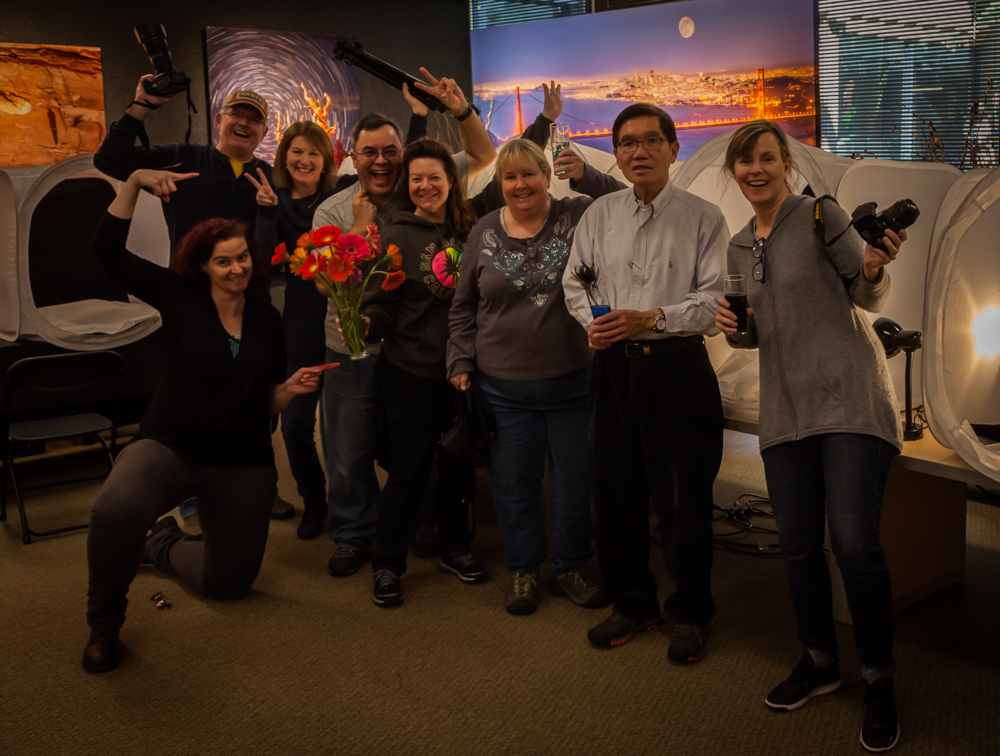
|
|
|||||
Winter can be a rough season for photographers. It's cold. It gets dark early and stays dark longer. Depending on where you live, either snow or rain can keep you indoors for days. So what do you do? I have an idea! You can learn about Macro photography! Macro photography is great because you can do it almost anyway, almost any time, under almost any conditions. Indoors, outdoors, low-light with a tripod, or bright light hand-held, Macro photography can keep your creative mind challenged all winter long. Sounds like fun, doesn't it?
That's what seven enthusiastic photographers thought as they came to our Aperture Academy Studio in San Jose, CA on a recent Saturday morning. Everyone arrived right on time, and I had set up everything we would need to learn a few things and hopefully have a lot of fun.
Our day began with quick introductions so I could get to know a little about my students, tell them what to expect from the day, and they could get to know a little bit about me. After introductions, I gave a brief presentation introducing Macro photography. I defined what characteristics are specific to Macro photography as opposed to "close-up" photography. I covered some of the equipment that is available and what makes a Macro lens unique. Next, I moved on to explain some of the more technical aspects of photography all of which apply to Macro photography. We covered the Exposure Triangle and how Aperture, ISO, and Shutter Speed work together to create your images, and how they specifically work with Macro photography. Finally, I reviewed the creative techniques of composition, including leading lines, rule of thirds. Understanding these principles will help you tell a story in your image that your viewer will enjoy. Then I showed some examples of where to find subjects to photographs along with images from my own portfolio so student could get an idea of the endless possibilities.
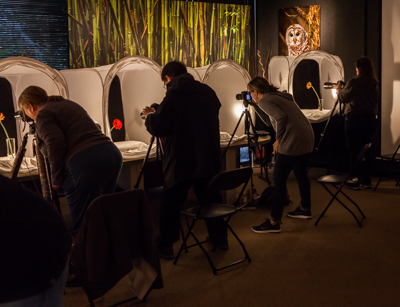 With the basics covered, it was time to get hands-on and start shooting. Each student set up their tripods and cameras at their own individual light stations. I took a moment to describe the three main subjects we would be working with and what the specific challenges were for each. Then I helped everyone get set up for the first round, and the fun began! Over the next 2 hours, my students were challenged to "see" each subject in a different way. I wanted them to see how the character of a subject changes depending on where the light source is, what angle you are shooting from, etc. Changing the direction of the light source can highlight details that didn't show up before. Changing the angle from which you shoot can showcase character details that would be otherwise unseen. But more than anything, I wanted my students to just have fun discovering what worked for them. This is one of the best aspects of the Workshop environment. Students can try all kinds of different settings and adjustments and get immediate feedback and critique, which can really help solidify the new principles and techniques.
With the basics covered, it was time to get hands-on and start shooting. Each student set up their tripods and cameras at their own individual light stations. I took a moment to describe the three main subjects we would be working with and what the specific challenges were for each. Then I helped everyone get set up for the first round, and the fun began! Over the next 2 hours, my students were challenged to "see" each subject in a different way. I wanted them to see how the character of a subject changes depending on where the light source is, what angle you are shooting from, etc. Changing the direction of the light source can highlight details that didn't show up before. Changing the angle from which you shoot can showcase character details that would be otherwise unseen. But more than anything, I wanted my students to just have fun discovering what worked for them. This is one of the best aspects of the Workshop environment. Students can try all kinds of different settings and adjustments and get immediate feedback and critique, which can really help solidify the new principles and techniques.
A very useful technique for Macro Photographers to learn is that of focus-stacking. We often find ourselves in situations that require us to shoot in shallow depths of field, either due to lack of light, or because we want a certain softness or tone to our images. Under those conditions, it can be difficult to get an image that is crisp and sharp all the way through and we end up with images that are sharp in some areas but not others. This challenge can be overcome by focus -stacking images. This technique involves taking a series of several images, each one with a different plane of the image in focus, so that when "stacked" in Photoshop, you get one image that is sharp all the way through. I took a bit of time and worked with each student to get their series of images that we could "stack" later during processing.
 After I had gone through each of the pre-set subjects, we still had a little time before lunch break. With no further planned subjects to shoot, I told everyone it was time for "recess" and that they could pick their own subject and let their creativity loose! This is the part of the class that I most enjoy. I can never predict what subjects the students will choose, and it is always fun to see what everyone picked and connected to. It is challenging to me as well as I try to help each student bring their vision to life. I was delighted to see that my students creativity had been unlocked and they were adventurously trying all kind of combinations of subject matter. I continued to work with everyone to help them capture their vision and it was clear that the concepts were becoming more familiar.
After I had gone through each of the pre-set subjects, we still had a little time before lunch break. With no further planned subjects to shoot, I told everyone it was time for "recess" and that they could pick their own subject and let their creativity loose! This is the part of the class that I most enjoy. I can never predict what subjects the students will choose, and it is always fun to see what everyone picked and connected to. It is challenging to me as well as I try to help each student bring their vision to life. I was delighted to see that my students creativity had been unlocked and they were adventurously trying all kind of combinations of subject matter. I continued to work with everyone to help them capture their vision and it was clear that the concepts were becoming more familiar.
Soon it was time to break for lunch and while my students went off in search of something yummy to eat, I transformed the studio into the processing lab. After lunch, everyone settled around the table and quickly got to importing their images into LightRoom so that we could see what our creative minds had come up with.
The processing portion of our workshop starts with how to import, review and select favorite images in the LightRoom Library module. Then, we moved to the Develop Module, where I covered how to crop an image, adjust exposure, contrast and white balance. Next, I showed how my students how to sharpen an image and minimize noise. The final touch was to add some slight vignetting, just to emphasize the focal point of an image. At that point the processing was done, so I covered how to export their finished images, highlighting the settings designed for either web posting or printing. Whew!! That was a lot of information!
But we still had one more thing to cover.... Remember that series of images we captured? We still needed to process them with the focus stacking technique. I showed my students how to select those images in the LightRoom catalog and open them in PhotoShop layers to align and blend for a final image that is sharp and crisp edge to edge. The final results were really wonderful to see! This is a technique that takes some practice, but now my students had one more tool in their photographic toolbag.
We were very quickly approaching the end of our time together, and I spend a bit more time addressing specific questions, and making some equipment and further workshop recommendations. But soon, with a final Thank You, I sent my students on their way to enjoy the rest of their day, ready to practice their new Macro Photography skills.
Until next time,
DeAnna, and the rest of the Aperture Academy team!
P.S. If you'd like to join us at one of our workshops, you can find the schedule/sign up here.
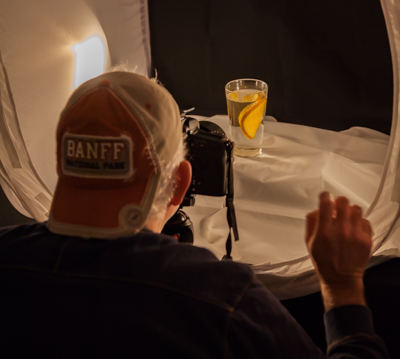 |
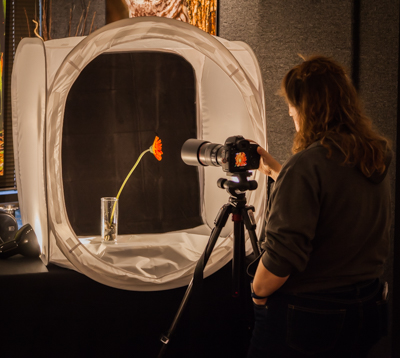 |
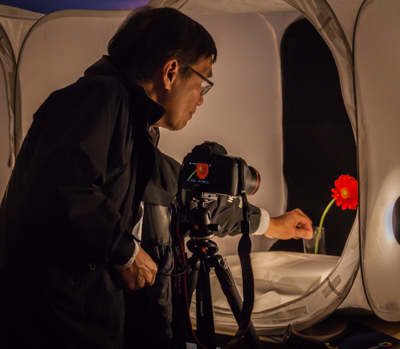 |
 |
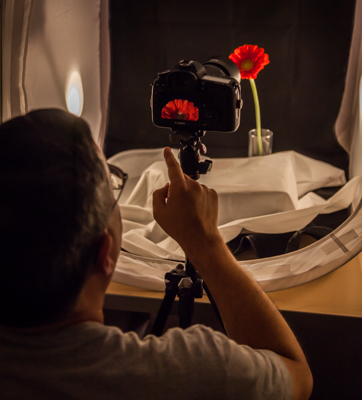 |
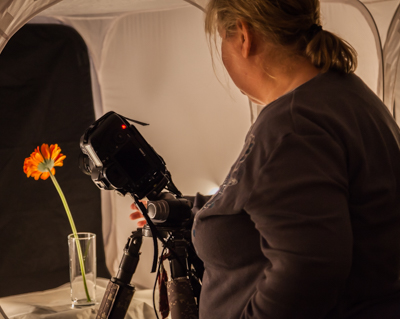 |
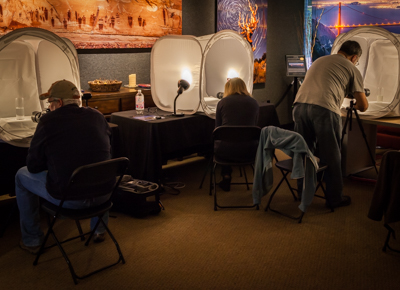 |
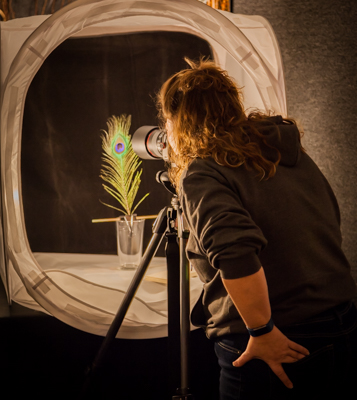 |
 | |
|
 |
Other Cool Stuff→ Past Workshop Photos → 72dpi.com → How-To Articles → Photographer of the Month |
 |
Contact Us→ Contact Us → About Us → Site Map |
© 2009-2024 Aperture Academy, Inc.
